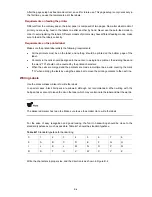
B-4
After the page setup has been made correct, save it for future use. This page setup is only necessary in
the first time you use the template to print the labels.
Requirements on feeding the printer
Different from the ordinary paper, the label paper is composed of two pages. No matter what model of
printer you are using, feed in the labels one after another by hand. Never use the auto-feed mode in
order to avoid jamming the labels. Different models of printers may have different feeding modes, make
sure to feed in the labels correctly.
Requirements on the printed label
Make sure the printed label satisfy the following requirements:
z
All the printouts must be on the label, and nothing should be printed on the bottom page of the
label.
z
Contents in the cells should be aligned in the center. In a single-line printout, the dividing lines and
the mark “TO” should not be covered by the printed characters.
z
When the cells are merged and the printouts are made in multiple lines, avoid covering the mark
“TO” when printing the texts by using the space bar to move the printing contents to the next line.
Writing Labels
Use the black oiliness markers to write the labels.
In special cases, black ball-pens are allowed, although not recommended. When writing with the
ball-pen, take care not to leave the oil on the label, which may contaminate the label and blur the words..
The delivered marker has two nibs. Make sure to use the smaller nib to write the labels.
For the sake of easy recognition and good looking, the font in handwriting should be close to the
standard typeface as much as possible. Table B-1 shows the standard typeface.
Table B-1
Standard typeface for handwriting
0 1 2 3 4 5 6 7 8
9 A B C D E F G H
I J K L M
N O
P Q
R S T U V W X Y Z
Write the characters in proper size, and the direction is as shown in Figure B-4:
















































